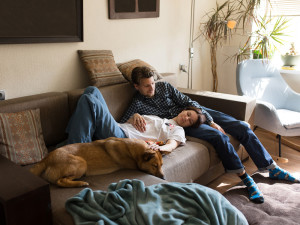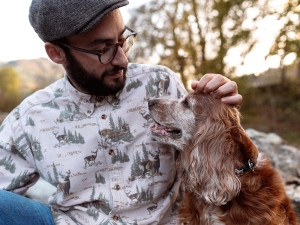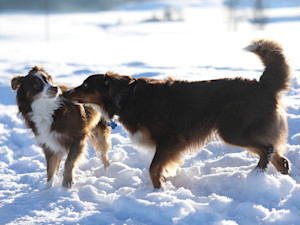Is It Weird to Go to a Dog Park If You Don’t Have a Dog?
Dog-watching is one of the best ways to pass time, even if you don’t have a pup. But will dog parents judge you?
My dog is not convinced that she is a dog. To be fair, neither am I. Physically, she is more of a dust bunny meets an actual bunny. Spiritually, she is a cat. Between the two of us, there’s one of us who would love to spend all day at a dog park, and the other one is her. So, even though I am very much a dog parent, I have asked myself on more than one occasion, Can I go to the dog park without a dog?
Outside of leasing an apartment or renting an Airbnb, there are few situations where you will be required to prove whether you own a pet. (However, if you do tell me you own a dog, it is required by law that you show me at least one to 300 photos and a video of them doing something cute.) The same applies to virtually all pet-friendly parks: You are not required to bring a dog in order to go to a dog park.
Trick question: All dogs are perfect! But find out which type is the best fit for you.
… Is it weird, though?
OK, sure, there aren’t any rules about going to a dog park without a dog, but why would you want to? I suppose there could be nefarious reasons for showing up sans dog. (i.e, to bully the ones you think are ugly, to collect all the poop for “research”). If you’re hanging out at a dog park, someone is bound to ask which one is yours out of politeness or curiosity. So, the real question becomes whether you can handle the social consequences of saying, “Oh, none. I’m just here to watch.”
Of course, that discomfort doesn’t need to discourage you entirely. Maybe, despite your love of dogs, you live in a building that doesn’t allow pets. Maybe you’re unable to have a dog right now because of finances. In one Reddit postopens in new tab on dog park etiquette, several comments mention people whose pet has recently died; these people found comfort in going to the dog park. Others who were looking to adopt a dog viewed the dog park as an opportunity to be exposed to a wide range of different dogs’ behavior.
How much do you spend on your pet per year?
Both science and dog lovers alike can attest that dogs benefit our mental health. One 2019 study from the University of Warwickopens in new tab among college students found that interacting with a dog helped decrease students’ anxiety and improve their mood over time. “Studies show that being around dogs has many health benefits, including reducing stress,” says Margaret, an animal shelter educator in Kansas City. In her opinion as both an animal educator and dog mom, it’s “completely fine to go to a dog park without a dog! Who doesn’t want to see a bunch of dogs after a difficult day at work?”
Be a good guest.
Dog parks, as the name suggests, are meant to cater to the pets. If you’re going to a dog park, with or without a dog, you should be mindful of any park rules. Are you allowed to bring in food and/or drinks? Are treats permitted? Most dog parks have their guidelines posted by the park entrance or listed on their website.
Additionally, be respectful of dog parents’ boundaries for their pets, and always ask before approaching their dog. “Remember that a dog park is not a petting zoo,” Margaret adds. “Not all dogs want to be touched or even approached by a stranger and that’s their right … If the dog doesn’t want to meet you, don’t take it personally and respect their decision.” Let the dogs interact with the other dogs. Don’t interfere with play for the sake of your safety, the dogs’ safety, and the added humiliation of being scolded by a pet’s parent.
This is less a rule and more a recommendation: Before you enter the park, do a quick count of the dog-to-person ratio. Are there a dozen humans and a couple dozen dogs or just a single family with their pet? Hanging out at a full dog park may be little less awkward than intruding on two strangers and their one dog. Regardless, try not to overstay your welcome.
Consider leaving your kids at home.
While most dog parks allow children as long as they are under adult supervision, kids can be an additional stressor for both the dogs and other adults at the park. “Some dogs are reactive to children,” Margaret cautions, adding that an excited dog could easily knock a small child over. Independently, dogs and kids require attentiveness when out in public.
Combined, their chaperone’s responsibility is amplified. If a parent isn’t able to keep a constant eye on both their child and dog, it makes the park more dangerous (and, in turn, less fun) for everyone. “It’s not a safe space for children, and it’s not meant to be,” Margaret adds, emphasizing that taking your family pet to a dog-friendly park may be a better option than bringing your kid to a park specifically for dogs.
Refresh yourself on how to greet a new dog.
It’s best to let any curious dog approach you, rather than galavanting about the dog park, looking for ears to scratch. Again, make sure to check with the dog’s parent before petting their pup. They will be more familiar with their pet’s body language and cues. Once a dog has approached you and you’ve gotten the OK from their parent the American Kennel Clubopens in new tab recommends using “dog-appropriate” greetings.
This includes limiting pets to the dog’s side, neck, back, and chest. AKC specifically mentions that you should avoid reaching over or approaching the dog’s head, which can be intimidating to some dogs. Keep your motions steady and calm, and give the dog space to leave if they want to.
There are other ways to spend time with dogs.
If you’re itching for opportunities to hang out with dogs, look into volunteering with a local shelter, becoming a shelter dog walker, signing up to be a foster parent, or taking an adoptable dog for a day outingopens in new tab.
If you don’t have the time to commit to volunteering or the courage to show up to a dog park without a dog, check out what bars and restaurants in your neighborhood are dog-friendly or dog-centric. Once you do your research, you’ll find more on your community’s dog-friendly list than you could have ever imagined.









